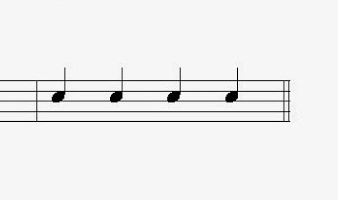Keep it steady
 Hi everyone! We’re about to jump into the world of counting. I’m going to introduce things like symbols and reading sheet music along the way, so be aware of that. However, first we’re going to stick with the basics and that doesn’t require anything written down. What I first want you to grasp is the idea that there is always a “beat” or “pulse” that continually plays throughout the music.
Hi everyone! We’re about to jump into the world of counting. I’m going to introduce things like symbols and reading sheet music along the way, so be aware of that. However, first we’re going to stick with the basics and that doesn’t require anything written down. What I first want you to grasp is the idea that there is always a “beat” or “pulse” that continually plays throughout the music.
The beat/pulse is exactly what you would expect it to be: basically the heartbeat of the music. Sometimes the heart beats in groups of 3. Usually it beats in groups of 4. There are others, but we’re going to stay mainly with the pulse beating in groups of 4 for now.
Before we go on, the beat should be completely steady. Again, this is just like your heartbeat. If your heartbeat is erratic, you have to go to the doctor, right? Same thing with the beat/pulse of the music you are playing.
There are some exceptions to this rule later on. But for our learning process, stick with the idea that you always want the beat to be completely predictable and regularly occurring.
Numbers are your friend
The very first concept we will be discussing is the idea that each beat is measured, or counted. In other words, each beat is assigned a number. It’s literally as simple as this:
[1-2-3-4]
What you see just above this sentence is 4 beats in a row. These 4 beats should be played as steady as the beating of a heart, or ticking of a clock. Each number only gets one tick on the clock. Now, the beat doesn’t stop at 4. However, rather than continue counting into infinity (a really, really, really big, never ending number), we start over again after “4”. Like this:
[1-2-3-4]-[1-2-3-4]-[1-2-3-4]-[1-2-3-4]
And etc, etc.
What this means is that we can start stringing together groups of 4 beats. These groups will later be called “measures”. Don’t worry, we’ll get to that. For now, let’s keep moving.
Assigning a note value
 In the video, I’m going to go more in depth with the counting process and give you some exercises to work with to really make sure you have this memorized. But for now, we’re going to move on. The next idea I’m going to throw at you is something called a “quarter note”.
In the video, I’m going to go more in depth with the counting process and give you some exercises to work with to really make sure you have this memorized. But for now, we’re going to move on. The next idea I’m going to throw at you is something called a “quarter note”.
Each number in the group of 4 will be a quarter note. Put in other terms, every beat in this example is a quarter note. So you’re going to have 4 quarter notes per group. As you can see in the example, I sectioned off each group just like that.
Now that we’ve seen how this works, I want you to imagine you’re a clock. Even better, if you have a clock, stopwatch, or wrist watch with a second hand I want you to clap your hands every time the second hand moves. Or in the case of a digital watch, clap every time you see a new number ticking away.
Great job! Now you’re clapping a beat! This is also sometimes used interchangeably with the word rhythm. When we get into more advanced theory, it’s not entirely correct to use these terms as synonyms, but for now, and for our purposes, it will work.
“The playing is the hardest part…”
Sure, I just took some liberties with that Tom Petty song. It’s a great tune. I have no regrets. However, often times, our attempts at playing our music with the correct written beat is difficult. Learning beats and rhythms, like most of music itself, takes time to see and memorize all the symbols you’ll need. I will help you with that, don’t worry. For now, let’s do some exercises with the beat on our violins!
I want you to use the A string for this, and I want you to simply get a stop watch, or a watch with a second hand (applications on your phone that create these will work fine.) We are going to play along as the seconds tick away. So, every time a second ticks on the stopwatch, or the second hand on a clock ticks, I want you to play an open “A” on the violin.
Full disclosure, this will get boring. However, this is the first step to being able to keep a beat and trust me, that is incredibly important in music! So, stick with this. You can also practice by changing up which string you play on, or moving back and forth from string to string just to keep things interesting.
The music staff, bar lines, and measures
 I want you to count in groups of 4, like we did earlier. In doing so, you’re preparing yourself to read sheet music. You’re actually counting 4 quarter notes in a row. If you start the very next beat/quarter note after 4 as a 1, you just counted one full measure. You can continue this as long as you like.
I want you to count in groups of 4, like we did earlier. In doing so, you’re preparing yourself to read sheet music. You’re actually counting 4 quarter notes in a row. If you start the very next beat/quarter note after 4 as a 1, you just counted one full measure. You can continue this as long as you like.
The last thing we are going to talk about is measures. Measures are made up of bar lines, seated on the music staff. The music staff is made up of 5 horizontal lines (and by default, 4 spaces inside of the lines). The bar lines separate the music staff into sections we call measures. Notes live on the lines and in the spaces of the measures.
It is inside these measures that we will place our quarter notes that we have been counting. Remember that we have been placing 4 quarter notes into each measure, then moving on to the next measure.
Final thoughts
 This article is getting long and there’s more to talk about. So Let’s conclude here. I want you to watch the video, and practice counting with me. For now, take a look at these images containing the staff, bar lines and measures, and quarter notes. Memorize what they look like and be ready to learn more in our next article. I’ll see you there!
This article is getting long and there’s more to talk about. So Let’s conclude here. I want you to watch the video, and practice counting with me. For now, take a look at these images containing the staff, bar lines and measures, and quarter notes. Memorize what they look like and be ready to learn more in our next article. I’ll see you there!
